Numerical Investigation of Unsteady Flow and Aerodynamic Noise Characteristics of an Automotive Axial Cooling Fan
Abstract
1. Introduction
2. Numerical and Experimental Methodologies
2.1. Operational Condition of An Axial Fan Model
2.2. Large Eddy Simulation Based on Smagorinsky–Lilly Model
2.3. Ffowcs-Williams and Hawkings (FW-H) Acoustics Model
2.4. Experimental Methodologies for Velocity and Aerodynamic Noise Measurements
3. Results and Discussion
3.1. Flow Characteristics over an Axial Fan
3.2. Aerodynamic Noise Characteristics
4. Conclusions
Author Contributions
Funding
Conflicts of Interest
References
- Available online: https://repairpal.com/radiator-fan-assembly (accessed on 6 June 2020).
- Allam, S.; Abom, M. Noise reduction for automotive radiator cooling fans. In Proceedings of the FAN 2015—International Conference on Fan Noise, Technology and Numerical Methods, Institution of Mechanical Engineers, Lyon, France, 17 April 2015. [Google Scholar]
- Abbas, A.; Elwali, W.; Haider, S.; Dsouza, S.; Sanderson, M.; Segan, Y. CAE Cooling Module Noise and vibration Prediction Methodology and Challenges. SAE Tech. Pap. 2020. [Google Scholar] [CrossRef]
- Chanaud, R.C.; Muster, D. Aerodynamic noise from motor vehicles. J. Acoust. Soc. Am. 1975, 58, 31–38. [Google Scholar] [CrossRef]
- Neise, W. Review of Fan Noise Generation Mechanisms and Control Methods, Fan Noise Symposium; CETIM: Seulis, France, 1992. [Google Scholar]
- Blake, W.K. Mechanics of Flow-induced Sound and Vibration. Vol. 2: Complex Flow Structure Interaction; Academic Press Inc.: London, UK, 1986. [Google Scholar]
- Goldstein, M.E. Aeroacoustics; McGraw-Hill International: New York, NY, USA, 1976. [Google Scholar]
- Ffowcs-Williams, J.E. Aeroacoustics. Ann. Rev. Fluid Mech. 1977, 9, 447–468. [Google Scholar] [CrossRef]
- Sharland, I.J. Sources of noise in axial flow fans. J. Sound Vib. 1964, 1, 302–322. [Google Scholar] [CrossRef]
- Lighthill, M.J. On sound generated aerodynamically: I. general theory. Proc. Roy. Soc. Lond. A 1952, 211, 564–587. [Google Scholar]
- Lighthill, M.J. On sound generated aerodynamically: II. Turbulence as a source of sound. Proc. R. Soc. Lond. A 1954, 222, 1–32. [Google Scholar]
- Lighthill, M.J. Jet noise. The Wright Brothers Lecture of 1963. AIAA J. 1963, 1, 1507–1517. [Google Scholar]
- Lilley, G.M. On the noise from jets, Noise Mechanism, AGARD-CP-131. AGARD Conf. Proc. 1974, 13, 1–12. [Google Scholar]
- Curle, N. The influence of solid boundaries upon aerodynamical sound. Proc. Roy. Soc. Lond. A 1955, 231, 505–514. [Google Scholar]
- Brentner, K.S.; Farassat, F. An analytical comparison of the acoustic analogy and kirchhoff formulations for moving surfaces. Aiaa J. 1988, 36, 1379–1386. [Google Scholar] [CrossRef]
- Ffowcs-Williams, J.E.; Hawkings, D.L. Theory relating to the noise of rotating machinery. J. Sound Vib. 1968, 10, 10–21. [Google Scholar] [CrossRef]
- Ffowcs-Williams, J.E.; Hawkings, D.L. Sound generation by turbulence and surfaces in arbitrary motion. Proc. Roy. Soc. Lond. 1969, 264, 321–342. [Google Scholar]
- Fukano, T.; Kodama, Y.; Senoo, Y. Noise generated by low pressure axial flow fan. I.: Modeling of the turbulent noise. J. Sound Vib. 1977, 50, 63–74. [Google Scholar] [CrossRef]
- Fukano, T.; Kodama, Y.; Takamatsu, Y. Noise generated by low pressure axial flow fan. II.: Effects of number of blades, chord length and camber of blade. J. Sound Vib. 1977, 50, 75–88. [Google Scholar] [CrossRef]
- Argüelles, D.K.M.; Fernández, O.J.M.; Blanco, M.E.; Santolaria, M.C. Numerical prediction of tonal noise generation in an inlet vaned low-speed axial fan using a hybrid aeroacoustic approach. J. Mech. Eng. Sci. 2009, 223, 203–210. [Google Scholar] [CrossRef]
- Vondervoort, R.V.D. Prediction of Aerodynamic Performance and Noise Production of Axial Fans. Master’s Thesis, University of Twente, Enschede, The Netherlands, 2015. [Google Scholar]
- Park, S.M.; Ryu, S.Y.; Cheong, C.; Kim, J.W.; Park, B.I.; Ahn, Y.C.; Oh, S.K. Optimization of the orifice shape of cooling fan units for high flow rate and low-level noise in outdoor air conditioning units. Appl. Sci. 2019, 9, 5207. [Google Scholar] [CrossRef]
- Moreau, S. Direct noise computation of low-speed ring fans. Acta Acust. United Acust. 2019, 105, 30–42. [Google Scholar] [CrossRef]
- Franzke, R.; Sebben, S.; Bark, T.; Willeson, E.; Broniewicz, A. Evaluation of the multiple reference frame approach for the modelling of an axial cooling fan. Energies 2019, 12, 2934. [Google Scholar] [CrossRef]
- Smagorinsky, J. General circulation experiments with the primitive equations 1. The basic experiment. Mon. Weather Rev. 1963, 91, 99–164. [Google Scholar] [CrossRef]
- Hinze, J. Turbulence, 2nd ed.; McGraw-Hill: New York, NY, USA, 1975. [Google Scholar]
- Lilly, D. A proposed modification of the Germano subgrid-scale closure method. Phys. Fluids A Fluid Dyn. 1992, 4, 633. [Google Scholar] [CrossRef]
- Kim, K.Y. A Study on the Prediction Method of Shroud Fan Broadband Noise. Ph.D. Thesis, Korea Advanced Institute of Science and Technology, Daejeon, Korea, 2007. [Google Scholar]
- Almutairi, J.H.; Jones, L.E.; Sandham, N.D. Intermittent bursting of a laminar separation bubble on an airfoil. Aiaa J. 2010, 48, 414–426. [Google Scholar] [CrossRef]
- Lou, W.; Hourmouziadis, J. Separation bubbles under steady and periodic-unsteady main flow conditions. J. Turbomach. 2000, 122, 634–643. [Google Scholar] [CrossRef]
- Hu, X.; Guo, P.; Wang, Z.; Wang, J.; Wang, M.; Zhu, J.; Wu, D. Calculation of external vehicle aerodynamic noise based on les subgrid model. Energies 2020, 13, 1822. [Google Scholar] [CrossRef]
- Brooks, T.; Pope, D.; Marcolini, M. Airfoil Self-Noise and Prediction. Technical Report; NASA Reference Publication: Hampton, VA, USA, 1989; p. 1218. Available online: https://ntrs.nasa.gov/search.jsp?R=19890016302 (accessed on 6 June 2020).
- Oerlemans, S. Wind Turbine Noise: Primary Noise Sources. Technical Report; National Aerospace Laboratory NLR(Royal Netherlands Aerospace Centre): Amsterdam, The Netherlands, 2011; Available online: https://reports.nlr.nl/xmlui/bitstream/handle/10921/117/TP-2011-066.pdf (accessed on 6 June 2020).
- Ray, E.F. Industrial Noise Series Part IV: Modeling Sound Propagation; Stoughton Chamber of Commerce: Stoughton, WI, USA, 2010. [Google Scholar]
- Mo, J.O.; Lee, Y.H. Numerical simulation for prediction of aerodynamic noise characteristics on a HAWT of NREL phase VI. J. Mech. Sci. Technol. 2011, 25, 1341–1349. [Google Scholar] [CrossRef]

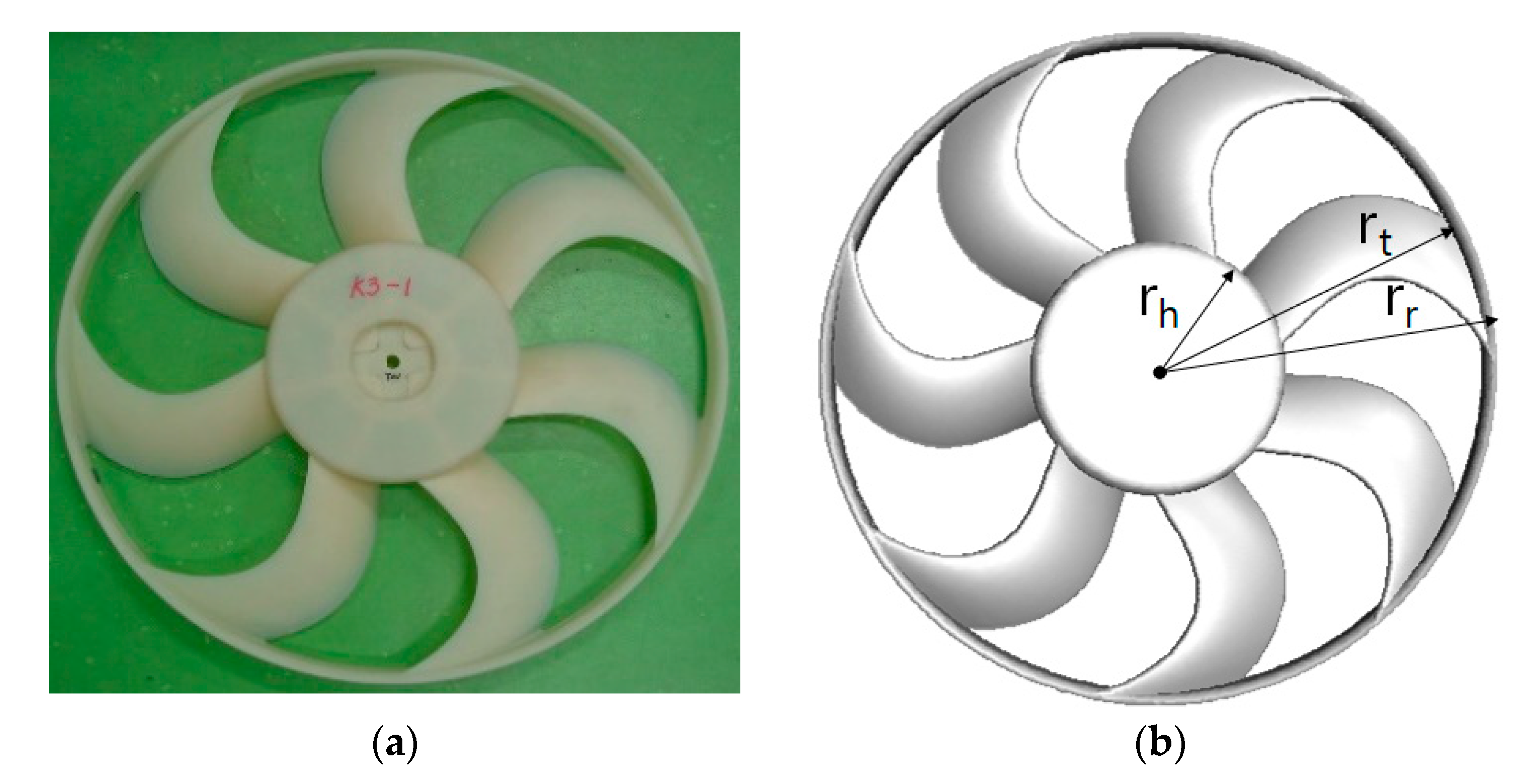
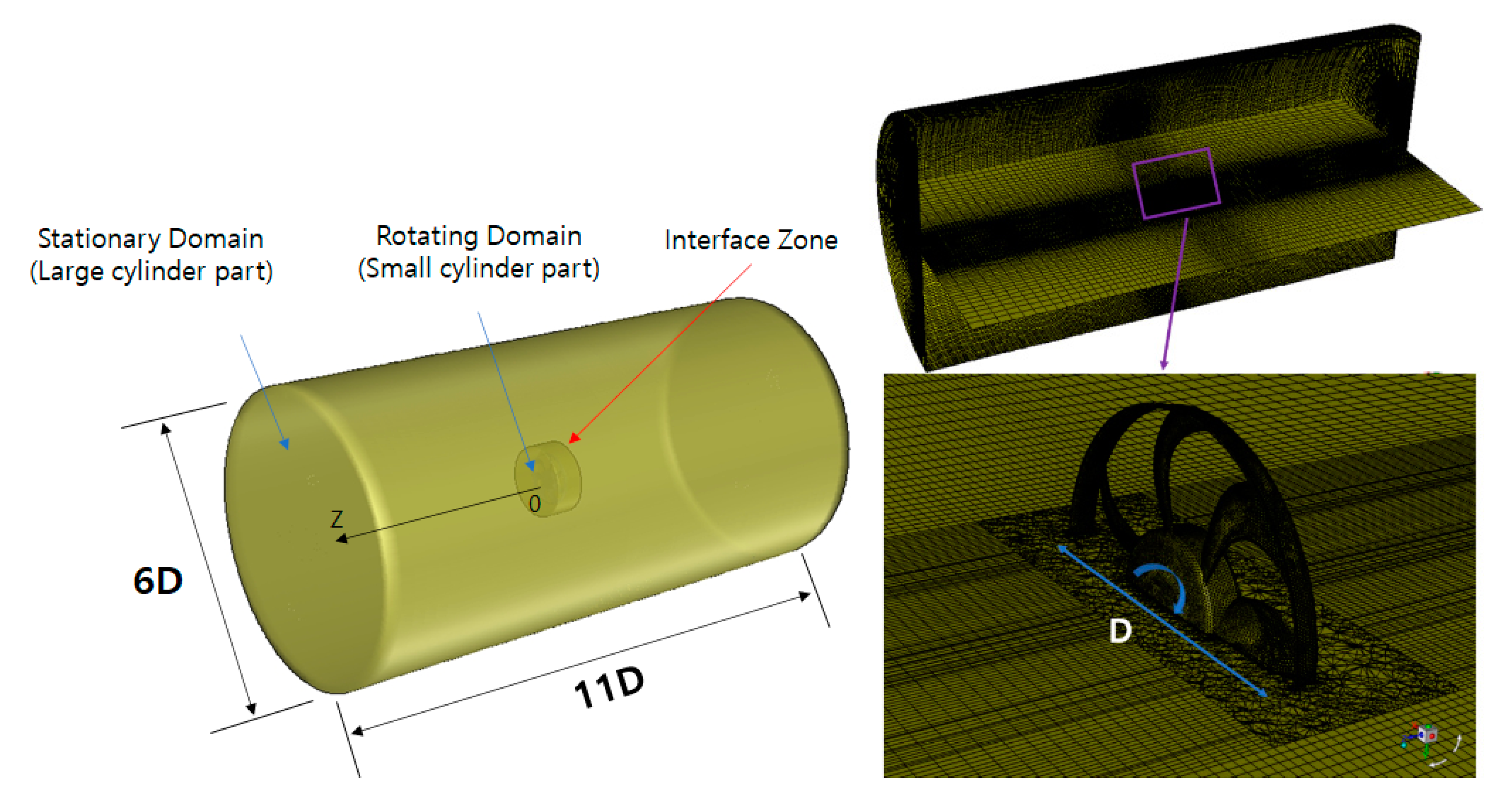
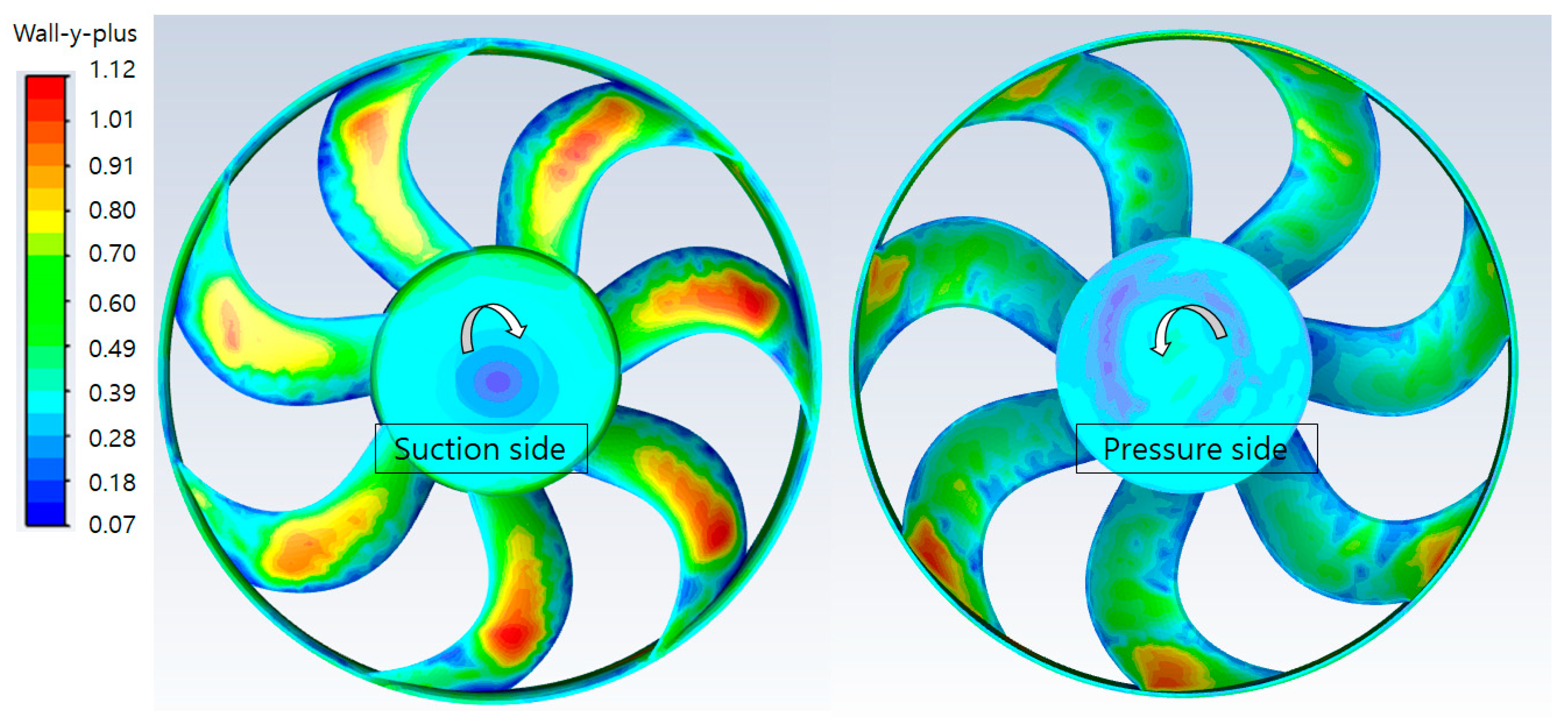


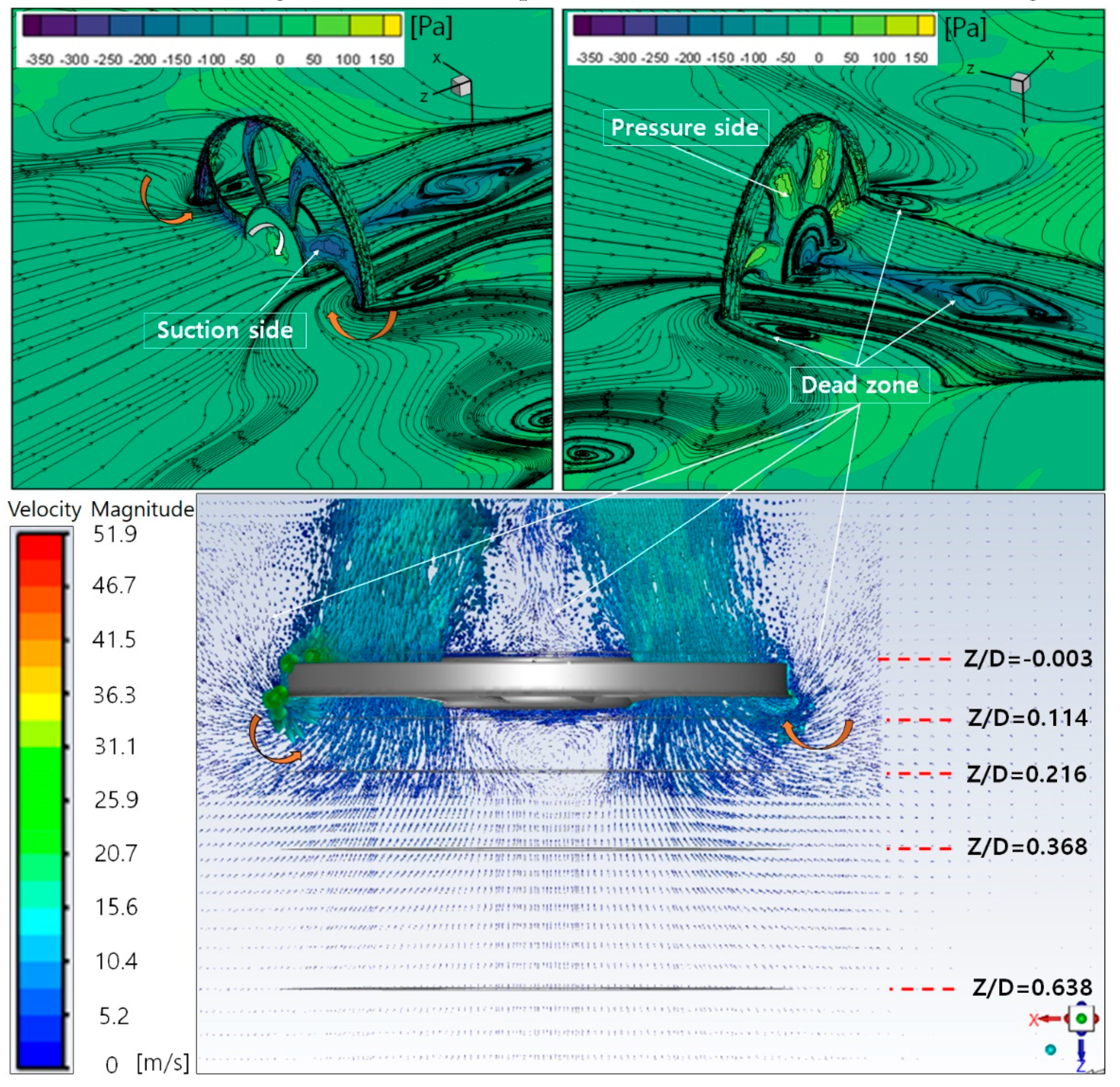
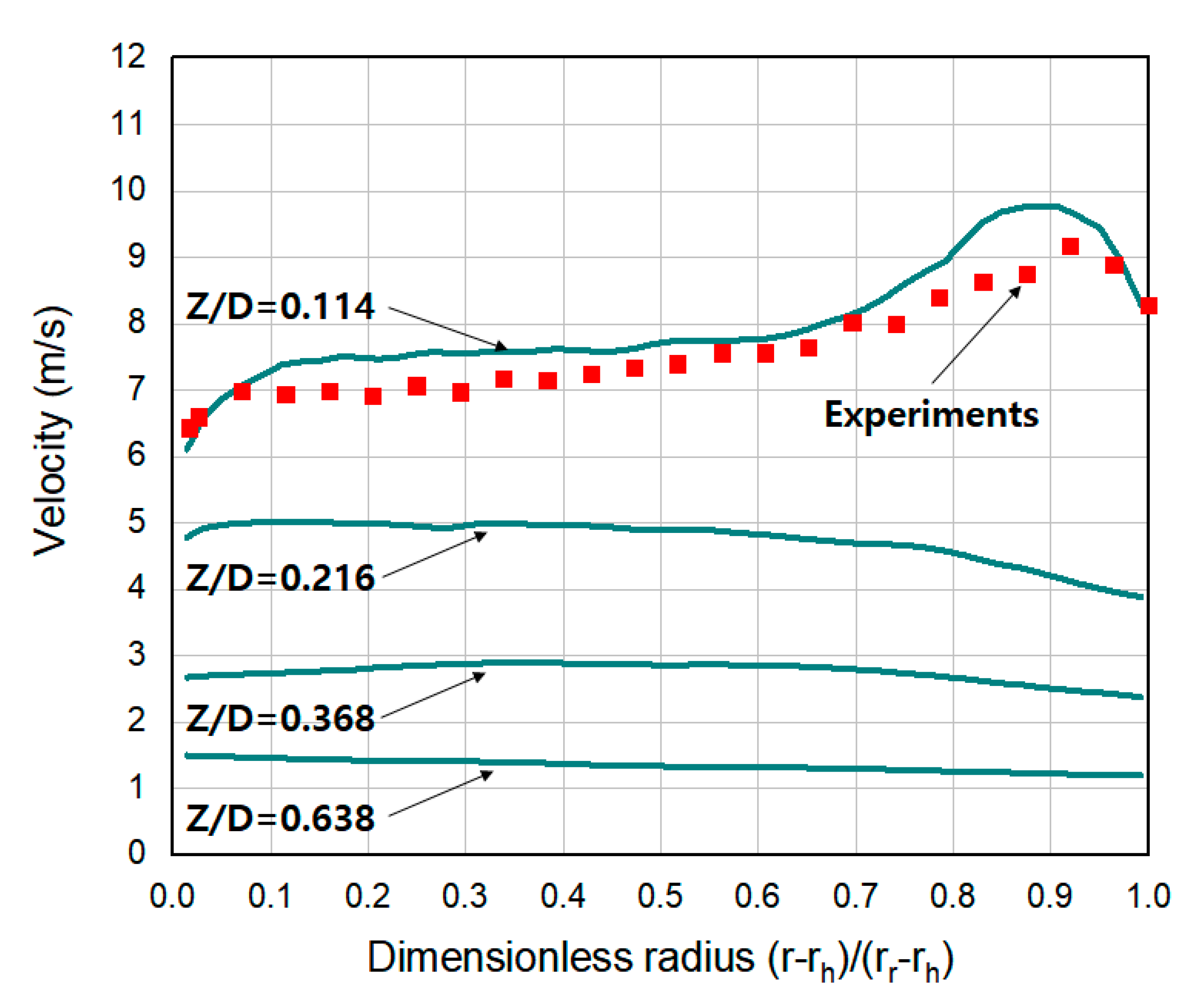

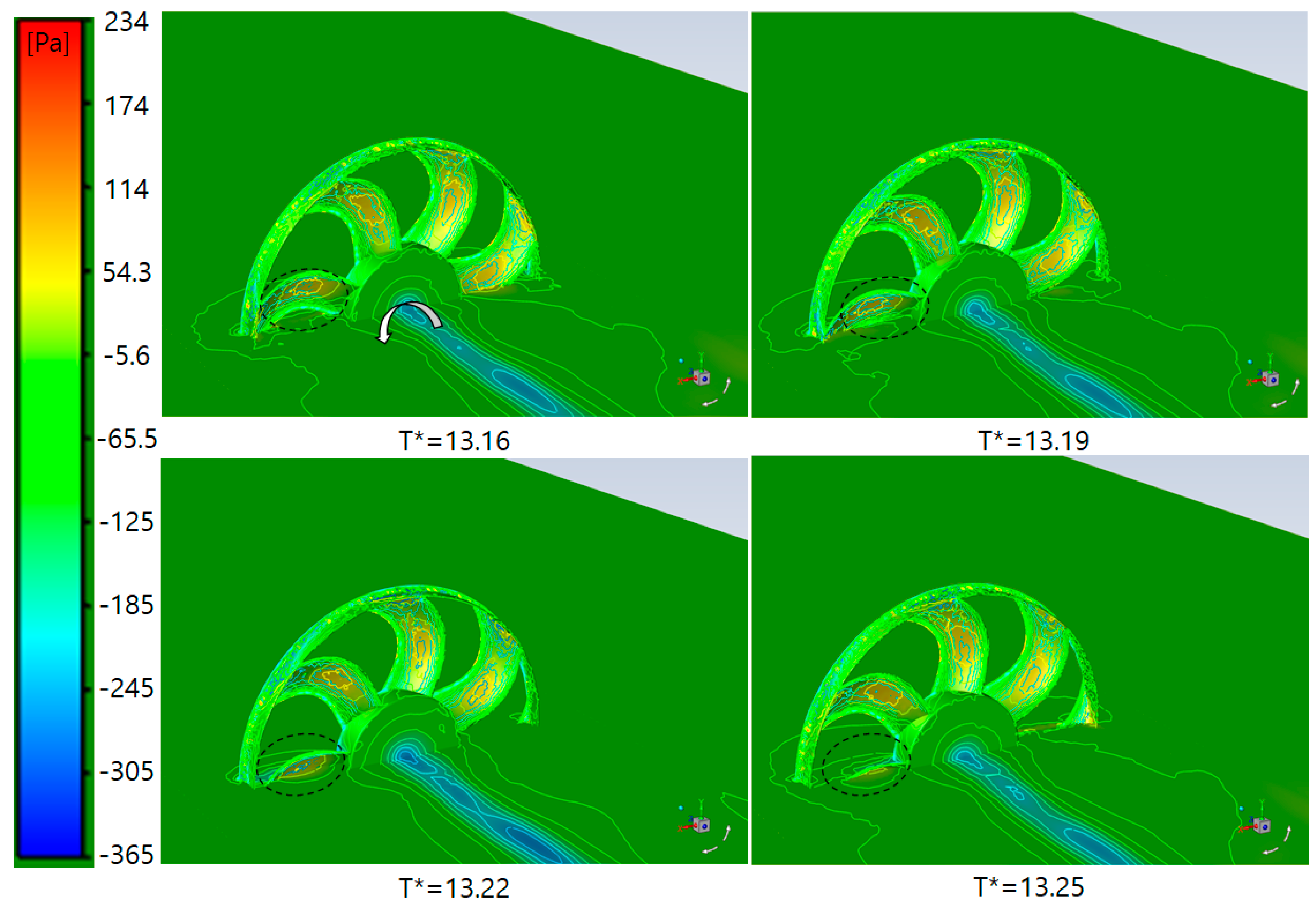
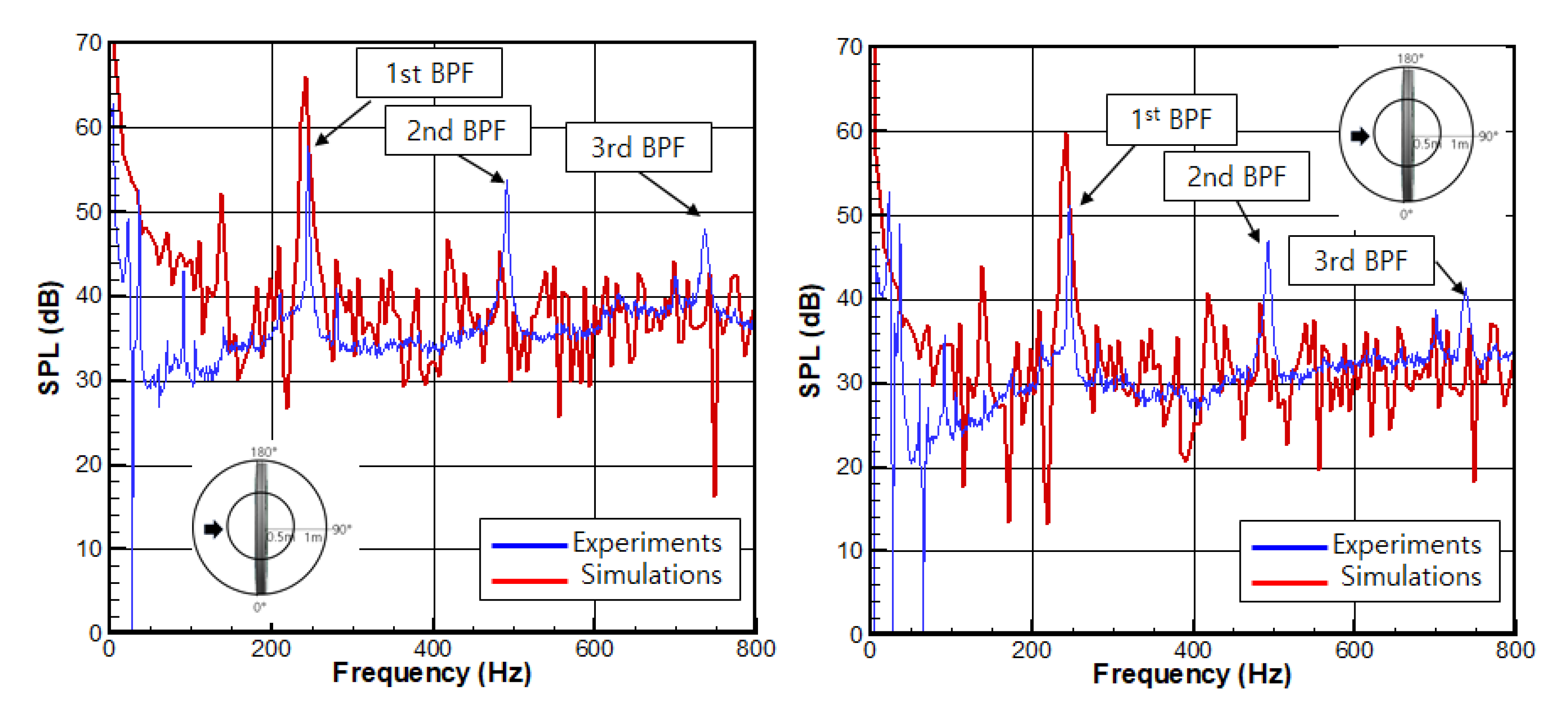
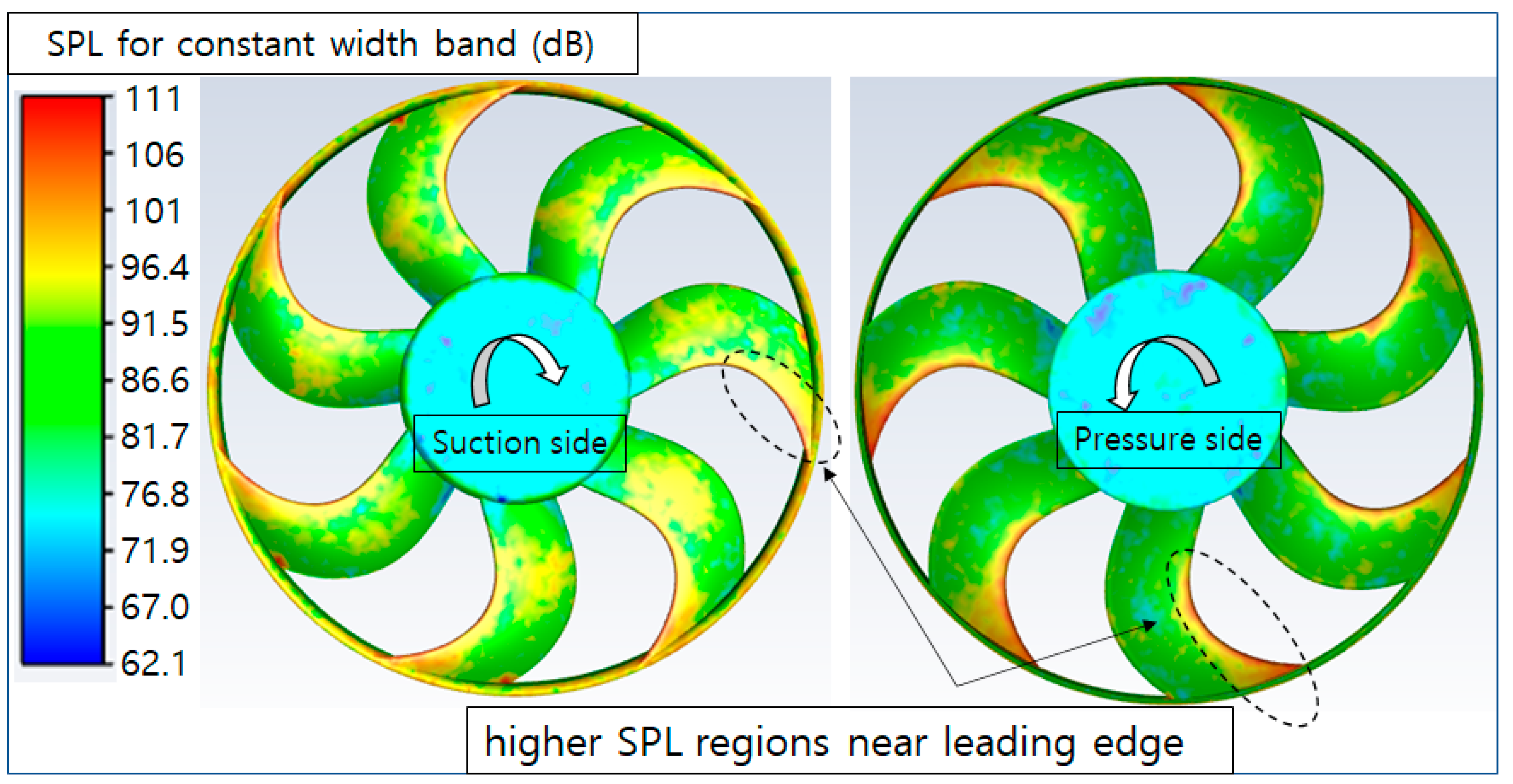
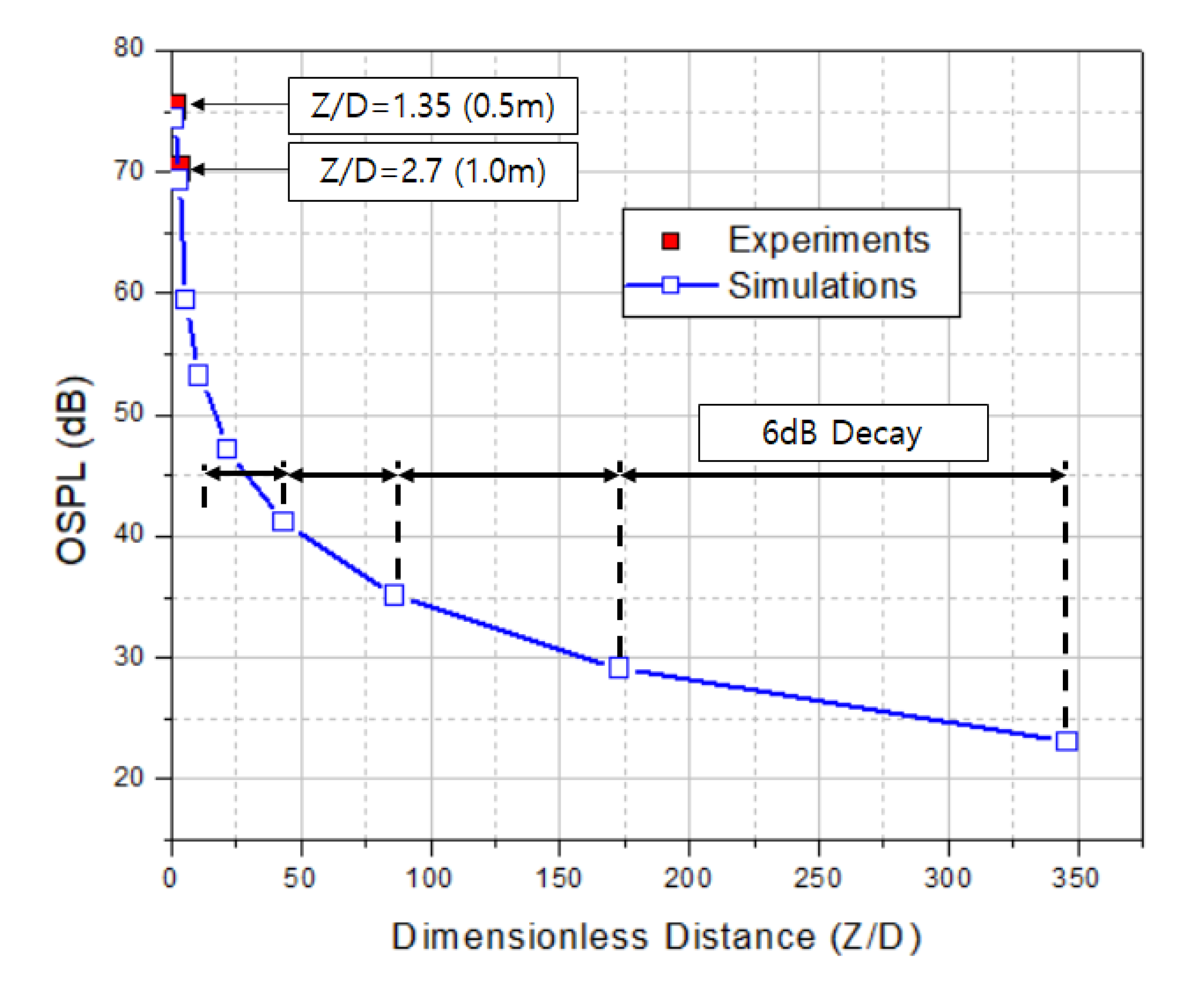
| Unit | rh | rt | rr |
|---|---|---|---|
| cm | 7 | 17.9 | 18.5 |
| Z/D | Fan (Blades + Rig + Hub) | Blades | Rig | Hub |
|---|---|---|---|---|
| 1.35 | 74.39 (100%) | 71.21 (69.3%) | 55.92 (10.6%) | 60.44 (20.1%) |
| 2.70 | 69.25 (100%) | 66.39 (71.6%) | 51.25 (12.5%) | 53.28 (15.8%) |
© 2020 by the authors. Licensee MDPI, Basel, Switzerland. This article is an open access article distributed under the terms and conditions of the Creative Commons Attribution (CC BY) license (http://creativecommons.org/licenses/by/4.0/).
Share and Cite
Mo, J.-o.; Choi, J.-h. Numerical Investigation of Unsteady Flow and Aerodynamic Noise Characteristics of an Automotive Axial Cooling Fan. Appl. Sci. 2020, 10, 5432. https://doi.org/10.3390/app10165432
Mo J-o, Choi J-h. Numerical Investigation of Unsteady Flow and Aerodynamic Noise Characteristics of an Automotive Axial Cooling Fan. Applied Sciences. 2020; 10(16):5432. https://doi.org/10.3390/app10165432
Chicago/Turabian StyleMo, Jang-oh, and Jae-hyuk Choi. 2020. "Numerical Investigation of Unsteady Flow and Aerodynamic Noise Characteristics of an Automotive Axial Cooling Fan" Applied Sciences 10, no. 16: 5432. https://doi.org/10.3390/app10165432
APA StyleMo, J.-o., & Choi, J.-h. (2020). Numerical Investigation of Unsteady Flow and Aerodynamic Noise Characteristics of an Automotive Axial Cooling Fan. Applied Sciences, 10(16), 5432. https://doi.org/10.3390/app10165432




